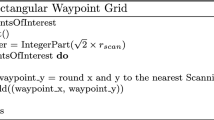Abstract
In the aftermath of radiation or chemical accidents, responders must rapidly map out regions of contamination as quickly and accurately as possible. One important and relevant statistical method for this kind of disaster response is spatial kriging, which makes predictions based on incomplete knowledge of spatially referenced observations. Given an Unmanned Aerial System (UAS) equipped with radiation sensors, we develop a spatial statistics-based approach to optimally map out a contamination field over a geographic region. In this article, we evaluate three approaches to UAS mapping: a Variance Driven Sampling (VDS) approach that minimizes kriging variance, a more computationally intensive Hybrid Entropy Search (HES), and a baseline Levy Flight search. Considering limited UAS range, we also implement a restricted version of these approaches that only considers nearby points. We find that HES is optimal for small numbers of sampled points with the restricted versions of HES and VDS becoming optimal for larger samples. Ultimately, the best method is dependent on the number of samples to be taken, with each method providing clear benefits over a random search in terms of both mean squared error and path length. We demonstrate the advantages of our methodology using actual radiation field test data from the Idaho National Lab.
Similar content being viewed by others
Explore related subjects
Discover the latest articles and news from researchers in related subjects, suggested using machine learning.Materials Availability
The data is provided as Appendix B. Code for reproducing results is available upon request from the corresponding author.
References
Avionics International: GE-Owned Avitas Granted First Large Commercial BVLOS Waiver. https://www.aviationtoday.com/2018/10/19/ge-owned-avitas-granted-first-large-commercial-bvlos-waiver/ (2018). Accessed 23 Oct 2018
Bueso, M., Angulo, J., Alonso, F.: A state-space model approach to optimum spatial sampling design based on entropy. Environmental and Ecological Statistics 5, 29–44 (1998). https://doi.org/10.1023/A:1009603318668
Cressie, N.: Kriging nonstationary data. Journal of the American Statistical Association 81(395), 625–634 (1986). http://www.jstor.org/stable/2288990
Cressie, N.: Origins of kriging. Math. Geol. 22(3), 239–252 (1990). https://doi.org/10.1007/BF00889887
Federal Aviation Administration: Unmanned Aircraft Systems Operational Approval (2013). http://www.faa.gov/documentlibrary/media/notice/n%208900.207.pdf
Federal Aviation Administration Office of the Secretary of Transportation: Fact Sheet – Small Unmanned Aircraft Regulations (14 CFR Part 107) (2016). www.faa.gov/news
Han, J.: Cyber-physical systems with multi-unmanned aerial vehicle-based cooperative source seeking and contour mapping (2014)
Karakaya, M.: Uav route planning for maximum target coverage. arXiv:1403.2906 (2014)
Marchant, R., Ramos, F.: Bayesian optimisation for intelligent environmental monitoring. In: 2012 IEEE/RSJ International Conference on Intelligent Robots and Systems, pp. 2242–2249. IEEE (2012)
Murphy, R.R., Peschel, J., Arnett, C., Martin, D.: Projected needs for robot-assisted chemical, biological, radiological, or nuclear (cbrn) incidents. In: 2012 IEEE International Symposium on Safety, Security, and Rescue Robotics (SSRR), pp. 1–4 (2012)
Pasztor, A.: Drones play increasing role in harvey recovery efforts. https://www.wsj.com/articles/drones-play-increasing-role-in-harvey-disaster-recovery-efforts-1504474194. Accessed: 27 Dec 2017 (2017)
Pulido Fentanes, J., Badiee, A., Duckett, T., Evans, J., Pearson, S., Cielniak, G.: Kriging-based robotic exploration for soil moisture mapping using a cosmic-ray sensor. Journal of Field Robotics 37 (1), 122–136 (2020). https://doi.org/10.1002/rob.21914. https://onlinelibrary.wiley.com/doi/abs/10.1002/rob.21914
Stein, M.L.: Asymptotically efficient prediction of a random field with a misspecified covariance function. Ann. Stat. 16, 55–63 (1988)
Stein, M.L.: Interpolation of spatial data: some theory for Kriging. Springer Science & Business Media (2012)
Vivaldini, K.C., Martinelli, T.H., Guizilini, V.C., Souza, J.R., Oliveira, M.D., Ramos, F.T., Wolf, D.F.: Uav route planning for active disease classification. Auton. Robot. 43(5), 1137–1153 (2019)
Wei, J., Chen, Y., Yu, Y., Chen, Y.: Optimal randomness in swarm-based search. Mathematics 7(9), 828 (2019)
Williams, K.W., Gildea, K.M.: A review of research related to unmanned aircraft system visual observers. Federal Aviation Administration Final Report (2014)
Acknowledgements
The authors would like to thank the reviewers and editor for several useful comments that greatly improved this work.
Funding
The authors did not receive support from any organization for the submitted work.
Author information
Authors and Affiliations
Contributions
Daniel Echeveste provided all coding and conducted all simulations in this manuscript. He originated the idea of entropy based sampling.
Andrew Lee provided subject matter expertise on UAS systems and ensured the algorithms provided were applicable for UAS systems.
Nicholas Clark provided statistical analysis and oversight for the project and served as Daniel Echeveste’s advisor for this work. He proposed the initial idea of using spatial statistics to inform flight paths.
Corresponding author
Ethics declarations
Conflict of Interests
The authors have no conflicts of interest to declare that are relevant to the content of this article.
Additional information
Disclaimer
The views expressed herein are those of the authors and do not reflect the position of the United States Military Academy, the Department of the Army, or the US Department of Defense.
Publisher’s Note
Springer Nature remains neutral with regard to jurisdictional claims in published maps and institutional affiliations.
Appendices
Appendix A: Log Scale MSE Plots
This appendix includes graphs of MSE on a \(\log \) scale, which makes difference in performance more clear.
Appendix B: Radiation Field Data
Rights and permissions
About this article
Cite this article
Echeveste, D., Lee, A. & Clark, N. Using Spatial Uncertainty to Dynamically Determine UAS Flight Paths. J Intell Robot Syst 101, 76 (2021). https://doi.org/10.1007/s10846-021-01331-3
Received:
Accepted:
Published:
DOI: https://doi.org/10.1007/s10846-021-01331-3









